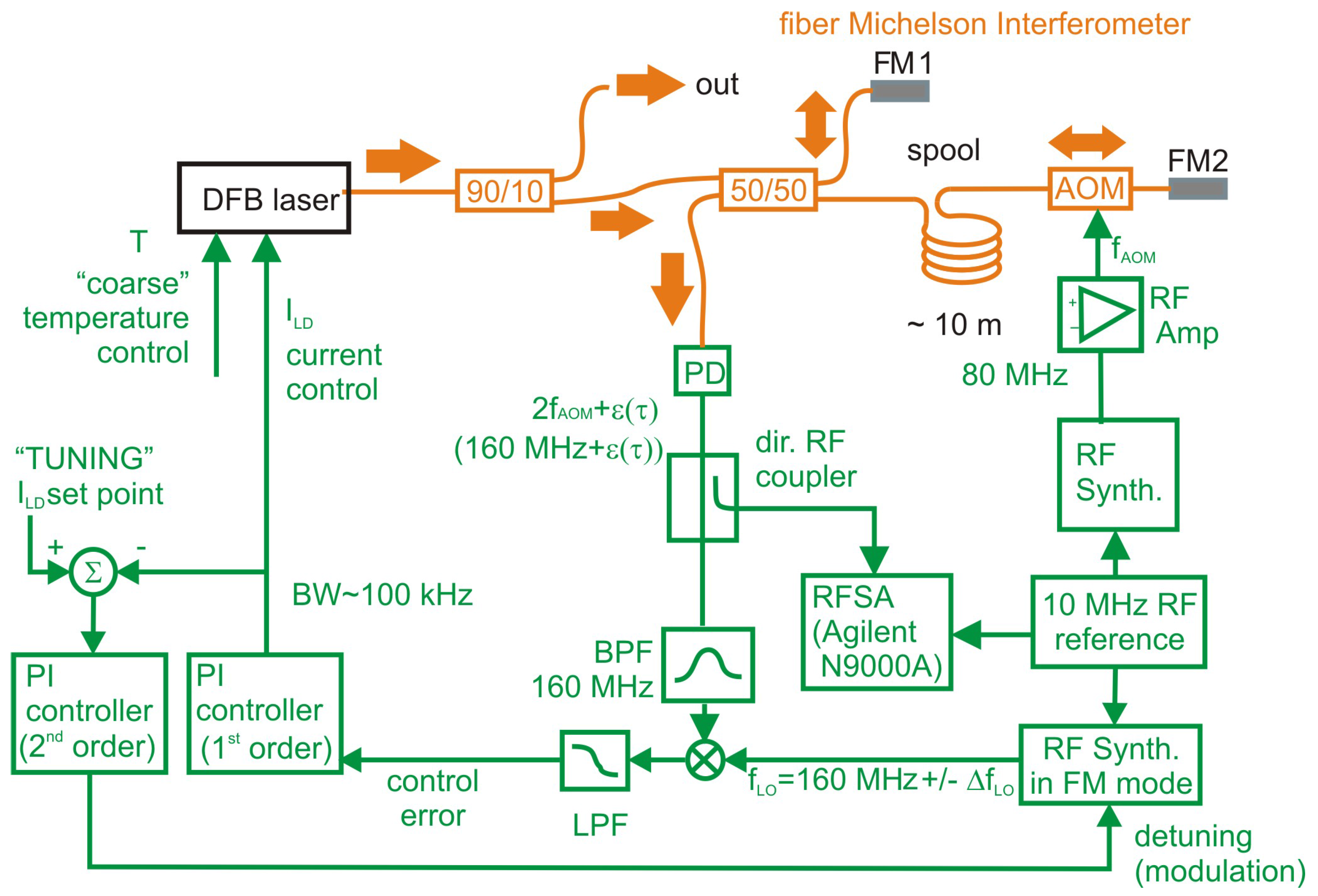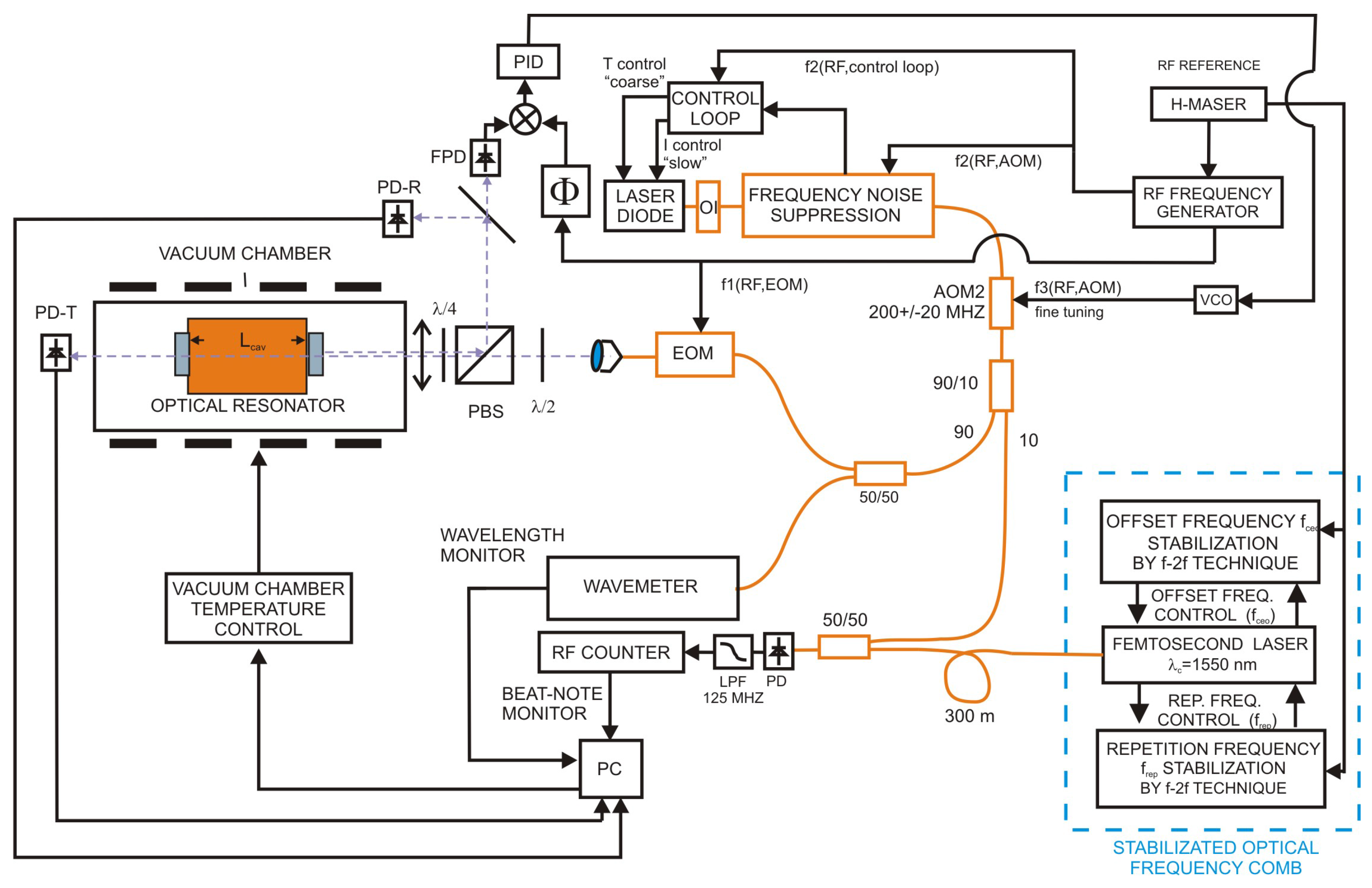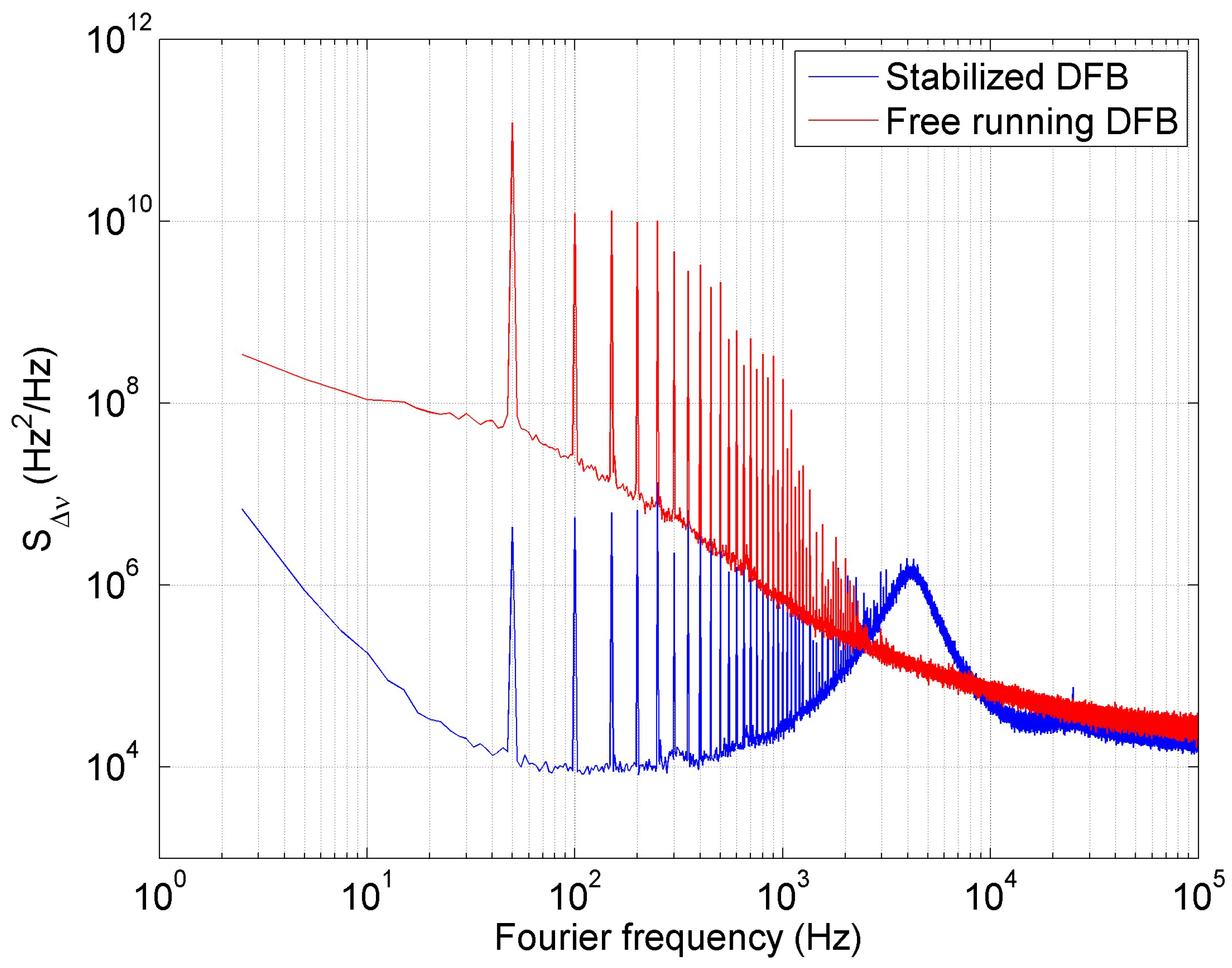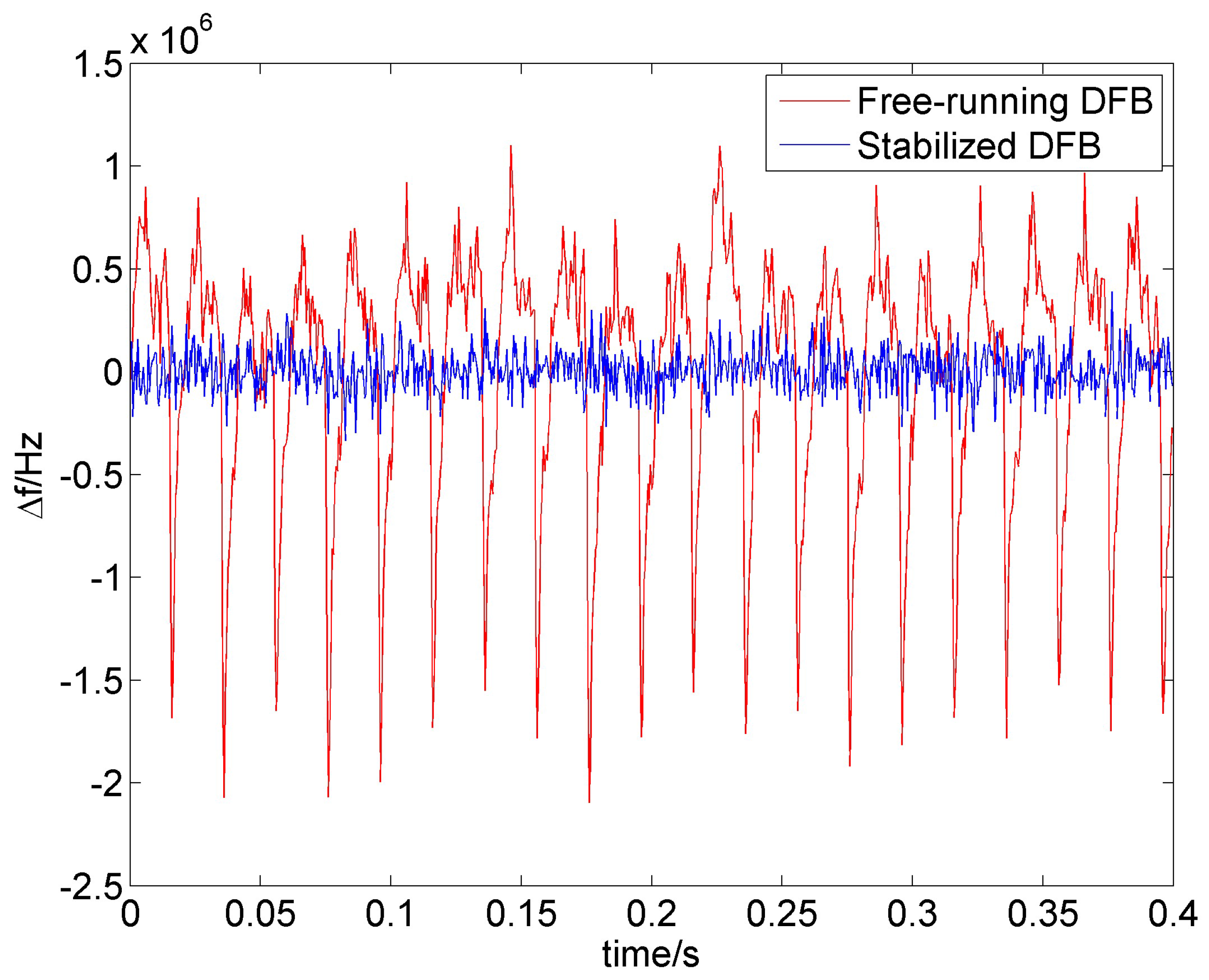Noise Suppression on the Tunable Laser for Precise Cavity Length Displacement Measurement
Abstract
:1. Introduction
2. Theory of Method
2.1. Principle of Displacement Measurement
2.2. Principle of Noise Suppression
- homodyne interferometric detection. The laser beam splits into two arms and the beam that comes from the longer arm is directly mixed with the beam coming from the shorter arm. The detected signal represents phase noise of the laser and the signal is set around DC. One disadvantage of such a method is that the flicker noise overlaps the detected signal. The bandwidth of frequency noise is limited by the equation [20]:where is the laser frequency, is the length difference between two fiber arms of the interferometer. In other words only certain discrete frequencies can be transmitted limited by the actual length of delay fiber:
- heterodyne interferometric detection. The laser beam splits into two arms and the optical frequency of the beam in one arm is frequency shifted by on an acousto-optic modulator (AOM) driven by the harmonic RF signal.
- Mach-Zehnder unbalanced interferometer where one arm is represented by the fiber spool with active length . The total delay of the interferometer is . That is for a typical optical fiber at 1550 nm (SMF-28 [25]) with a fused silica core and refractive index of , thus the delay ranges from 5.4 ns for 1 m long fiber to for 1 km long arm.
- Michelson unbalanced interferometer where one arm is represented by the fiber spool and both arms are ended by the Faraday mirrors. The active length is twice the active length of Mach-Zehnder interferometer hence the delay is and the useful bandwidth is half of the maximal frequency .
3. Experimental Set-up
3.1. Noise Suppression Scheme
3.2. Displacement Measurement Set-up
4. Results
4.1. Laser Frequency Noise Analysis
4.2. Frequency Beat Measurement
5. Conclusion
Acknowledgments
Author Contributions
Conflicts of Interest
References
- Bay, Z.; Luther, G.G.; White, J.A. Measurement of an Optical Frequency and the Speed of Light. Phys. Rev. Lett. 1972, 29, 189–192. [Google Scholar] [CrossRef]
- Šmíd, R.; Číp, O.; Lazar, J. Precise length etalon controlled by stabilized frequency comb. Meas. Sci. Rev. 2008, 8, 114–117. [Google Scholar] [CrossRef]
- Šmíd, R.; Číp, O.; Čížek, M.; Mikel, B.; Lazar, J. Conversion of Stability of Femtosecond Mode-Locked Laser to Optical Cavity Length. IEEE Trans. Ultrason. Ferroelectr. Freq. Control 2010, 57, 636–640. [Google Scholar] [CrossRef] [PubMed]
- Číp, O.; Šmíd, R.; Čížek, M.; Buchta, Z.; Lazar, J. Study of the thermal stability of Zerodur glass ceramics suitable for a scanning probe microscope frame. Cent. Eur. J. Phys. 2012, 10, 447–453. [Google Scholar] [CrossRef]
- Lawall, J.R. Fabry-Perot metrology for displacements up to 50 mm. J. Opt. Soc. Am. A 2005, 22, 2786–2798. [Google Scholar] [CrossRef]
- Lazar, J.; Číp, O. Electronics for He-Ne-I2 stabilized laser with digital control. Rev. Sci. Instrum. 1997, 68, 3660–3665. [Google Scholar] [CrossRef]
- Petru, F.; Lazar, J.; Číp, O.; Popescu, G.; Chartier, J. Frequency comparison of He-Ne/iodine lasers at 633 nm between the NILPRP and the ISI, and traceability through the BIPM. Metrologia 1997, 34, 515–518. [Google Scholar] [CrossRef]
- Drever, R.W.P.; Hall, J.L.; Kowalski, F.V.; Hough, J.; Ford, G.M.; Munley, A.J.; Ward, H. Laser Phase and Frequency Stabilization Using an Optical Resonator. Appl. Phys. B 1983, 31, 97–105. [Google Scholar] [CrossRef]
- Picard, S.; Robertsson, L.; Ma, L.-S.; Nyholm, K.; Merimaa, M.; Ahola, T.E.; Balling, P.; Křen, P.; Wallerand, J.-P. Comparison of 127I2-stabilized frequency-doubled Nd:YAG lasers at the Bureau International des Poids et Mesures. Appl. Opt. 2003, 42, 1019–1028. [Google Scholar] [CrossRef] [PubMed]
- Udem, T.; Holzwarth, R. Hänsch Optical frequency metrology. Nature 2002, 416, 233–237. [Google Scholar] [CrossRef] [PubMed]
- Quinn, T.J. Mise-en-pratique of the definition of the meter (1992). Metrologia 1994, 30, 523–541. [Google Scholar] [CrossRef]
- Navratil, V.; Fodrekova, A.; Gata, R.; Blabla, J.; Balling, P.; Ziegler, M.; Zeleny, V.; Petru, F.; Lazar, J.; Vesela, Z.; et al. International comparisons of He-Ne lasers stabilized with I-127(2) at lambda approximate to 633 nm (July 1993 to September 1995)—Part III: Second comparison of Eastern European lasers at lambda approximate to 633 nm. Metrologia 1998, 35, 799–806. [Google Scholar] [CrossRef]
- Hrabina, J.; Petru, F.; Jedlicka, P.; Cip, O.; Lazar, J. Purity of iodine cells and optical frequency shift of iodine-stabilized He-Ne lasers. Optoelectron. Adv. Mat. 2007, 1, 202–206. [Google Scholar]
- Morthier, G.; Vankwikelberge, P. Handbook of Distributed Feedback Laser Diodes; Artech House: Norwood, MA, USA, 1997. [Google Scholar]
- Lazar, J.; Číp, O.; Ružička, B. The design of a compact and tunable extended-cavity semiconductor laser. Meas. Sci. Technol. 2004, 15, N6–N9. [Google Scholar] [CrossRef]
- Buchta, Z.; Číp, O.; Lazar, J. High-power extended cavity laser optimized for optical pumping on Rb. Meas. Sci. Technol. 2007, 18, N77–N80. [Google Scholar] [CrossRef]
- Redfern Integrated Optics Product List. Available online: http://www.rio-lasers.com/_products/orion.html (accessed on 25 August 2016).
- Balling, P.; Fischer, M.; Kubina, P.; Holzwarth, R. Absolute frequency measurement of wavelength standard at 1542nm: Acetylene stabilized DFB laser. Opt. Express 2005, 13, 9196–9201. [Google Scholar] [CrossRef] [PubMed]
- ULE Corning Code 7972, Ultra Low Expansion Glass. Available online: https://www.corning.com/media/worldwide/csm/documents/7972%20ULE%20Product%20Information%20Jan%202016.pdf (accessed on 25 August 2016).
- Jiang, H.; Kéfélian, F.; Lemonde, P.; Clairon, A.; Santarelli, G. An agile laser with ultra-low frequency noise and high sweep linearity. Opt. Express 2010, 18, 3284–3297. [Google Scholar] [CrossRef] [PubMed]
- Clivati, C.; Mura, A.; Calonico, D.; Levi, F.; Constanzo, G.A.; Calosso, C.E.; Godone, A. Planar-Waveguide External Cavity Laser Stabilization for and Optical Link With 10−19 Frequency Stability. IEEE Trans. Ultrason. Ferroelectr. Freq. Control 2011, 58, 2582–2587. [Google Scholar] [CrossRef] [PubMed]
- Šmíd, R.; Čížek, M.; Mikel, B.; Číp, O. Frequency Noise Suppression of a Single Mode Laser with an Unbalanced Fiber Interferometer for Subnanometer Interferometry. Sensors 2015, 15, 1342–1353. [Google Scholar] [CrossRef] [PubMed]
- Durand, M.; Lawall, L.; Wang, Y. High-accuracy Fabry-Perot displacement interferometry using fiber lasers. Meas. Sci. Technol. 2011, 22, 094025. [Google Scholar] [CrossRef]
- Čížek, M.; Hucl, V.; Hrabina, J.; Šmíd, R.; Mikel, B.; Lazar, J.; Číp, O. Two-Stage System Based on a Software-Defined Radio for Stabilizing of Optical Frequency Combs in Long-Term Experiments. Sensors 2014, 14, 1757–1770. [Google Scholar] [CrossRef] [PubMed]
- Corning SMF-28 Optical Fiber, Product Information. Available online: http://ece466.groups.et.byu.net/notes/smf28.pdf (accessed on 25 August 2016).
- Li, T.; Argence, B.; Haboucha, A.; Jiang, H.; Dornaux, J.L.; Koné, D.; Clairon, A.; Lemonde, P.; Santarelli, G.; Nelson, C.; et al. Low Vibration Sensitivity Fiber Spools for Laser Stabilization. In Proceedings of the 2011 Joint Conference of the IEEE International Frequency Control and the European Frequency and Time Forum (FCS), San Francisco, CA, USA, 2–5 May 2011.
- Derickson, D. Fiber Optic Test and Measurement; Prentice Hall: Upper Saddle River, NJ, USA, 1998. [Google Scholar]
- Abramovici, A.; Chapsky, J. Feedback Control Systems, A Fast-Track Guide for Scientists and Engineers; Springer: Berlin, Germany, 2010. [Google Scholar]
- Domenico, G.; Schilt, S.; Thomann, P. Simple approach to the relation between laser frequency noise and laser line shape. App. Opt. 2011, 49, 4801–4807. [Google Scholar] [CrossRef] [PubMed]
- Edlen, B. The Refractive Index of Air. Metrologia 1966, 2, 71–80. [Google Scholar] [CrossRef]




| No. | t (°C) | Opt. Frequency (MHz) |
|---|---|---|
| 1 | ||
| 2 | ||
| 3 |
© 2016 by the authors; licensee MDPI, Basel, Switzerland. This article is an open access article distributed under the terms and conditions of the Creative Commons Attribution (CC-BY) license (http://creativecommons.org/licenses/by/4.0/).
Share and Cite
Šmíd, R.; Čížek, M.; Mikel, B.; Hrabina, J.; Lazar, J.; Číp, O. Noise Suppression on the Tunable Laser for Precise Cavity Length Displacement Measurement. Sensors 2016, 16, 1428. https://doi.org/10.3390/s16091428
Šmíd R, Čížek M, Mikel B, Hrabina J, Lazar J, Číp O. Noise Suppression on the Tunable Laser for Precise Cavity Length Displacement Measurement. Sensors. 2016; 16(9):1428. https://doi.org/10.3390/s16091428
Chicago/Turabian StyleŠmíd, Radek, Martin Čížek, Břetislav Mikel, Jan Hrabina, Josef Lazar, and Ondřej Číp. 2016. "Noise Suppression on the Tunable Laser for Precise Cavity Length Displacement Measurement" Sensors 16, no. 9: 1428. https://doi.org/10.3390/s16091428
APA StyleŠmíd, R., Čížek, M., Mikel, B., Hrabina, J., Lazar, J., & Číp, O. (2016). Noise Suppression on the Tunable Laser for Precise Cavity Length Displacement Measurement. Sensors, 16(9), 1428. https://doi.org/10.3390/s16091428





